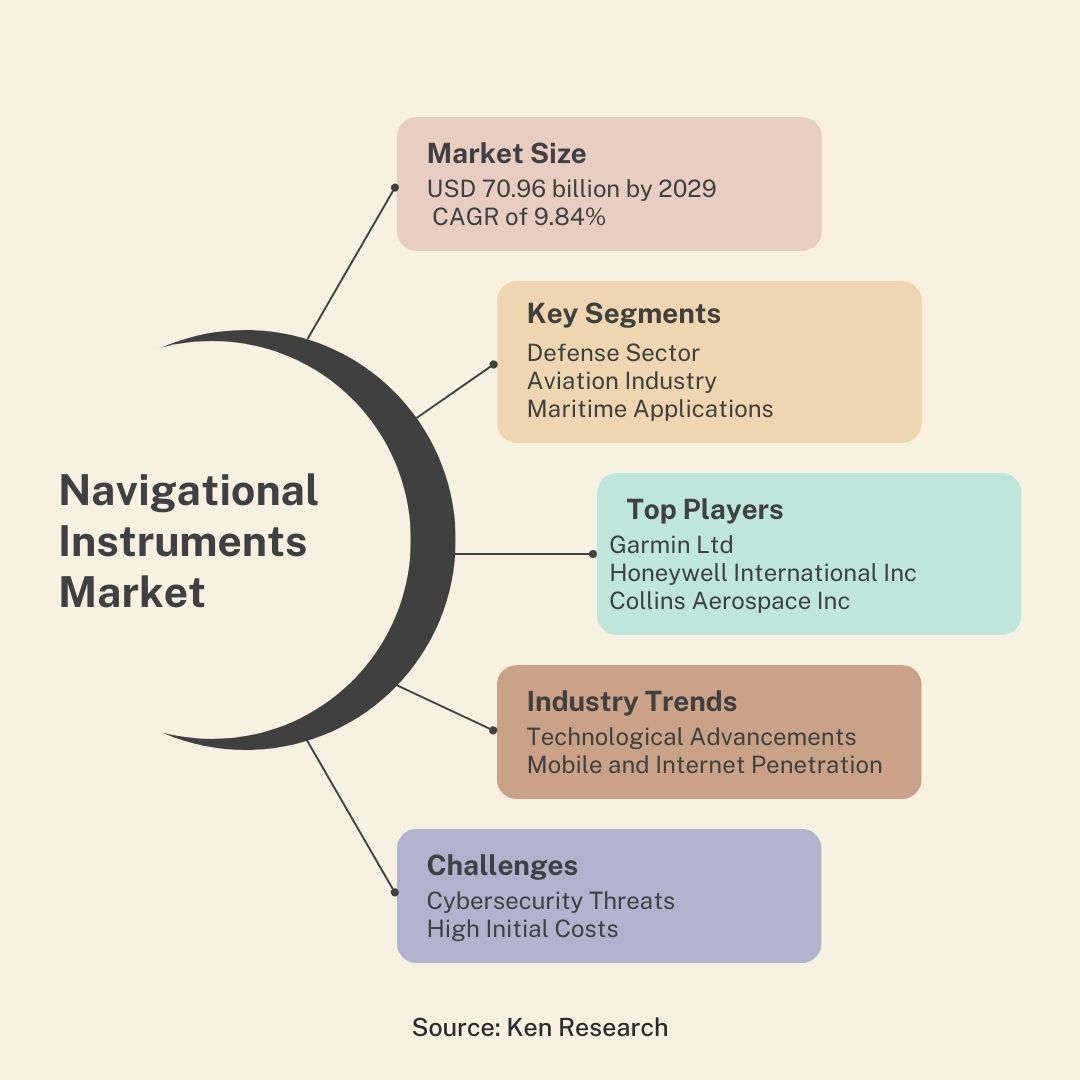The navigational instruments market is poised for significant growth. Market size is USD 44.38 billion in 2024, it is projected to reach USD 70.96 billion by 2029, growing at a CAGR of 9.84% during this period 2024-2029. This growth is driven by the increasing demand for real-time information in applications ranging from automotive to autonomous robots.

Key Segments in the Navigational Instruments Industry
- Defense Sector: The defense sector is a significant user of navigational instruments, relying on them for ground navigation, aerial monitoring, and maritime navigation. These systems enhance the accuracy, reliability, and precision of military operations.
- Aviation Industry: In aviation, navigational instruments are essential for flight safety and efficiency. Advanced navigation systems help manage air traffic, ensure safe landings, and optimize flight paths.
- Maritime Applications: Maritime navigation relies heavily on these instruments for route planning, collision avoidance, and efficient cargo handling. The increase in global trade and maritime traffic has spurred demand in this sector.
- Automotive Sector: In the automotive industry, navigation systems are used in passenger vehicles, autonomous cars, and fleet management. These systems enhance driving safety, efficiency, and overall user experience.
- Emerging Applications: Emerging applications include smart spaces and automated robots, where navigation systems provide critical data for operations and efficiency.
Major Players in the Navigational Instruments Sector
Several top players in the navigational instruments market, each contributing to its growth through innovation and strategic partnerships.
- Garmin Ltd.: Garmin is renowned for its GPS technology, catering to automotive, aviation, and marine markets with advanced navigation solutions.
- Honeywell International Inc.: Honeywell provides comprehensive navigation solutions for aerospace, defense, and industrial applications, emphasizing precision and reliability.
- Collins Aerospace Inc.: Collins Aerospace offers a wide range of navigation systems for military and commercial aviation, known for their cutting-edge technology.
- Safran Electronics & Defense Inc.: Safran specializes in high-precision navigation systems for defense and aerospace, focusing on innovation and resilience.
- KVH Industries Inc.: KVH provides advanced navigation solutions for maritime and defense sectors, emphasizing real-time data and robust performance.
Navigational Instruments Industry Trends
The navigational instruments market is trends exciting growth & transformation, driven by several key trends
- Technological Advancements Instruments are going beyond basic navigation, offering features like real-time traffic updates, weather data integration, voice assistance, and even self-learning capabilities to optimize routes.
- Mobile and Internet Penetration: The widespread use of smartphones and mobile internet is fueling the adoption of navigation apps and connected navigation devices.
- Advancements in Aerospace and Defense: The growing demand for improved security and efficiency in these sectors is driving innovation in high-precision navigation systems. This includes areas like autonomous military drones and advanced ship navigation tech.
- Integration with Virtual Reality (VR): VR technology is being explored to enhance navigation training simulations, particularly in aviation and maritime applications.
- Focus on Autonomous Vehicles: The development of self-driving cars and other autonomous vehicles is a major driver for high-performance and reliable navigation systems. This includes LiDAR, radar, and camera-based navigation solutions.
Challenges and Opportunities in the Navigational Instruments Sector
The navigational instruments industry is brimming with potential, but also faces some hurdles to overcome.
Challenges
- Cybersecurity Threats: As navigation instruments become increasingly connected, the risk of cyberattacks on critical infrastructure and data breaches rises. Robust security measures are crucial to address this.
- High Initial Costs: Developing and implementing advanced navigation systems can be expensive, especially for complex technologies like LiDAR. This can hinder adoption, particularly in developing economies.
- Workforce Skills Gap: The growing sophistication of these instruments necessitates a skilled workforce with specialized knowledge to operate and maintain them. Educational programs need to adapt to bridge this gap.
- Economic Fluctuations: Global economic slowdowns and budgetary constraints can limit investments in new equipment and upgrades, impacting navigational instruments market growth.
- Supply Chain Disruptions: Geopolitical tensions, trade wars, and resource scarcity can disrupt the flow of materials needed for instrument production.
Opportunities
- Environmental Sustainability: Developing energy-efficient and eco-friendly navigation instruments is a growing trend. This caters to the rising focus on environmental responsibility.
- Emerging Markets: Developing economies are experiencing increasing demand for navigation instruments, particularly in sectors like agriculture and maritime.
- Integration with IoT (Internet of Things): The integration of navigation instruments with the Internet of Things (IoT) allows for real-time data collection, analysis, and improved efficiency in various applications.
- Advancements in Satellite Technology: Developments in satellite constellations and improved accuracy of global navigation systems will open doors for new applications and services.
- Augmented Reality (AR) Integration: AR technology has the potential to revolutionize navigation experiences, offering a more intuitive and interactive way to navigate environments.
Read Also:- The Navigational Instruments Industry Size, Market Trends, Growth and Major Players
Components of Navigational Instruments Sector
- Satellite Navigation Systems: Satellite Navigational Instruments Industry like GPS, Galileo, and GLONASS offer high precision and global coverage, making them indispensable for various navigation applications.
- Inertial Navigation Systems: Inertial Navigational Instruments use accelerometers and gyroscopes to determine location and orientation without external references. They are crucial for submarines, aircraft, and unmanned vehicles.
- Radar Systems: Radar systems are used extensively in aviation, maritime, and automotive industries to detect objects and ensure safe navigation.
- Sonar Systems: Sonar systems are vital for underwater navigation and are widely used in marine industries and defense sectors.
Conclusion
Navigational instruments are integral to various industries, offering critical solutions for positioning, direction, and timing. The market is poised for significant growth, driven by technological advancements and increasing demand across sectors. Despite challenges such as high costs and regulatory hurdles, the future of the navigational instruments market looks promising, with significant opportunities for expansion and innovation.


